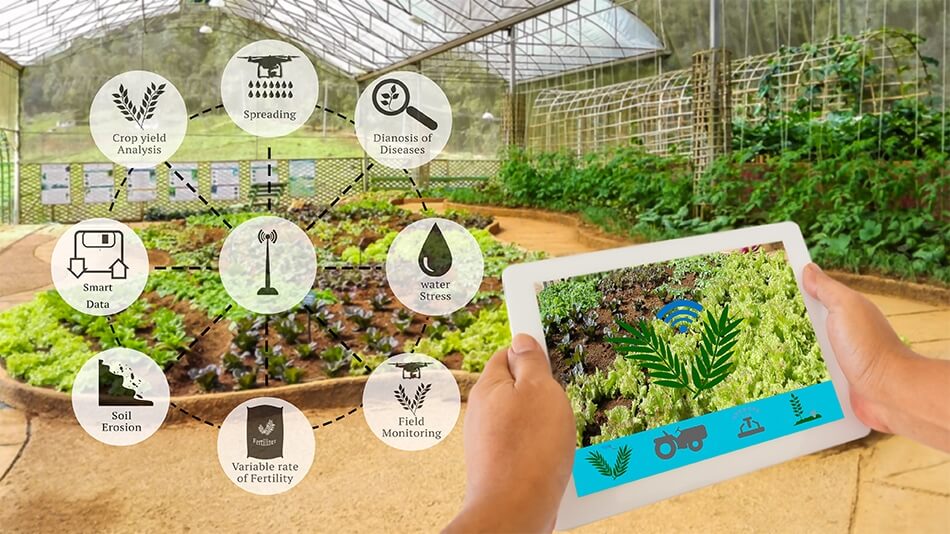
Vertical Farms and Vertical Farming
The practice of growing agriculture crops in vertically-stacked layers, commonly known as vertical farming, often incorporates controlled environment agriculture (CEA) and soilless farming techniques; such as hydroponics, aquaponics, and aeroponics.
Hydroponics
Hydroponics refers to the technique of growing plants without soil. Inert mediums, such as gravel, sand, and rockwool, are used as soil substitutes to provide support for the roots. Because hydroponics have proven to increase yield per area and reduce water usage, it is the predominant growing system used in vertical farming. A study published in the International Journal of Environmental Research and Public Health found that, compared to conventional farming, hydroponic farming could increase the yield per area of lettuce by around 11 times while requiring 13 times less water.
Aquaponics
The term aquaponics is a portmanteau formed by combining aquaculture – which refers to fish farming, and hydroponics – the technique of growing plants without soil. By integrating the production of terrestrial plants with the production of aquatic organisms, aquaponics takes hydroponics one step further. In a closed-loop system that mimics nature itself, plants consume carbon dioxide produced by the fish and the water in the fish tanks generates heat that helps the farm maintain temperature at night to save energy. Given that most commercial vertical farming systems focus on producing fast-growing vegetable crops, aquaponics is currently not as widely used as conventional hydroponic systems.
Aeroponics
Unlike conventional hydroponics and aquaponics, aeroponics does not require any liquid or solid medium to grow plants. Instead, a liquid solution with nutrients is misted in air chambers where the plants are suspended. When compared to the most efficient conventional hydroponic systems, this process uses up to 90% less water. The absence of a growing medium allows aeroponic systems to adopt a vertical design. This uses gravity to automatically drain away excess liquid, which further saves energy.
Our experts are available to share their insight and recommendations on the best performing farming systems for your indoor farm. For simple answers to your tough questions, select the ‘Get Started’ button below.
Advantages of Vertical Farming
The primary goal of vertical farming is to maximize crop output in a limited space. In the pursuit of that goal, vertical farming is producing more food per square meter driven by advantages like the following:
Smaller Environmental Footprint
One of the greatest advantages of implementing vertical farming technologies is the increased crop yield produced on a smaller parcel of land. Generally, crops are cultivated in stacked layers and innovations such as rotating beds are used to improve lighting efficiency. Because it does not cause significant land surface disturbance, vertical farms are less disruptive to the native plants and animals. This helps to improve biodiversity and leads to further conservation of the local flora and fauna.
Increased Productivity
Enjoying a sheltered placement indoors, crops are resistant to weather disruptions. In addition to resulting in fewer crops being lost to extreme or unexpected weather occurrences, this allows farms to produce crops throughout the year. All-season farming multiplies the productivity of the farmed surface by a factor of four to six, depending on the crop. With crops such as strawberries, the factor may be as high as 30.
Improved Performance
Current applications of vertical farming coupled with other state-of-the-art technologies, such as specialized LED lights, have resulted in crop yields that are more than 10 times the production of traditional farming methods. The benefits of this are further compounded by the indoor farm’s ability to cultivate a large variety of crops at once.
Low Labour Costs
Fully automated indoor growing systems do not need huge amounts of manual labour to achieve successful year-round production. People with low-level skills are still required to sort and pack harvests, but labour overheads will remain low – even if production is scaled upwards.
Vertical Farming Is Growing Up
Farming in a protected, well-monitored and managed environment provides assurance and peace of mind for growers, as well as repeatable programmable production of crops.
Using revolutionary vertical farming methods and technologies, it is now possible to produce large and consistent quantities and quality of food. A one acre indoor area offers the production equivalent of at least four to six acres of outdoor farmland. According to an independent estimate, a 30-story building with a base area of five acres has the potential to produce the equivalent of 2,400 acres of conventional horizontal farming.
To learn more about planning and building a successful vertical farm, select the ‘Get Started’ button below for insight and recommendations from our indoor farming experts.
